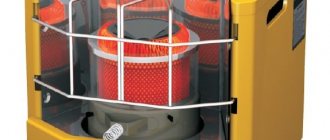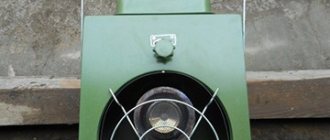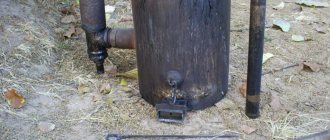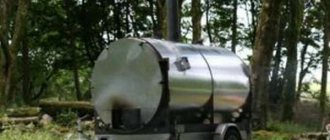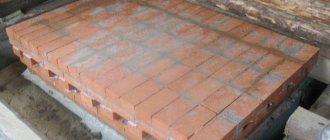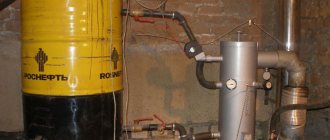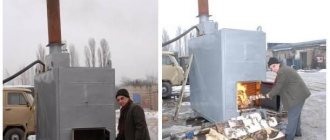Diesel fuel stove
A stove using diesel fuel (diesel fuel) is essentially the same kerosene gas, only modified and having a modern appearance.
It justifies its name due to its small size, simplicity of design and operation, in contrast to, for example, a homemade miracle furnace for mining, which has a rather complex configuration.
This is a heating device designed for heating or heating a country house, industrial premises, stalls. The device is universal; it can also be used for cooking or boiling water.
The heater, powered by diesel fuel, is suitable for installation in your garage or workshop. In a house, even a country house, its use is not recommended - when igniting and extinguishing the combustion, fuel vapors and an unpleasant odor will inevitably enter the room.
The compact, self-contained unit is also used as an emergency heat source and for cooking during power outages, and food can be cooked by installing a stove outside.
In addition to compactness and light weight, a diesel fuel stove is characterized by cost-effectiveness and high efficiency. The fuel burns with virtually no emissions into the atmosphere and with high thermal energy output. This makes the liquid fuel unit more practical than a classic wood-burning stove.
During operation, you should carefully monitor compliance with safety rules - flammable objects should not be placed near the operating stove.
The list of objects that can be effectively heated with such a stove:
- greenhouses, greenhouses;
- basements, basements;
- country houses, similar structures on the site;
- garages, utility rooms, workshops, tents, cabins;
- Living spaces.
Why working off?
Drip fuel supply is widely used in heating engineering when a heat output of approx. up to 15 kW. The principle of operation of a drip furnace is simple: liquid fuel drips into a heated evaporator, into which primary air is supplied. Each drop evaporates and partially burns immediately, maintaining the temperature of the evaporator. The remaining fuel vapors enter the combustion chamber with the influx of secondary air, where they burn completely. Thus, in drip furnaces, 2-stage fuel combustion is carried out. Unlike stoves with non-pressure burners, where the fuel heats only itself until it evaporates, in drip stoves part of the heat from the combustion of each drop is spent on heating a rather massive evaporator, which determines their lower efficiency. But there are ways to minimize this disadvantage, see below.
The maximum power of a drip furnace is largely determined by the properties of the fuel: if, in order to obtain a given amount of heat, the fuel must be released in a trickle, the furnace becomes fire and explosive. Mining in this regard is good because its viscosity and surface tension are high, i.e. It is possible to obtain frequent and large drops of waste. Diesel fuel is significantly worse in these parameters, although it is still possible to make a stove using waste fuel and diesel, see below. Drip stoves are not made with light liquid fuel - it is dangerous. Fuel oil and oil sludge are too valuable as fuel, and industrial-scale sources of heavy fuels are too stable to be burned haphazardly.
Main types of diesel fuel stoves
There are several main types of diesel stoves:
- Mini oven with wick.
Such heating devices can be purchased at the store. The design of the furnace consists of two main parts - a fuel tank and an open reservoir. The vessels are interconnected, and the fuel supply is controlled using a special valve.
Another essential element of a mini-stove is a wick, the tip of which is immersed in a vessel with fuel. The diesel fuel supply is adjusted thanks to a special valve.
After turning the valve, the valve between the communicating vessels opens, thereby saturating the wick with the flammable mixture. In the same way, the device turns off, cutting off the fuel supply.
This stove is lit manually. A match or lighter is suitable for this. It is worth lighting the wick a couple of minutes after opening the valve. You must also wait 10 minutes for the oven to warm up. Afterwards, the autonomous diesel stove will work independently.
The diesel fuel mini-oven turns off 5 minutes after you turn off the valve.
- Heat gun.
Heating units of this type are designed to heat large areas (from 30 m²) in all weather conditions. A diesel stove is a warm air blower in the form of a pipe mounted on wheels for ease of movement.
A turbine built at the end of this pipe is responsible for creating the air flow. The burner for the stove, which burns diesel fuel, is placed inside the combustion chamber and is washed with air from all sides.
There are 2 types of heat guns:
- Directly heated. This means that the air passing through the pipe is heated by the walls of the chamber and mixed with the combustion products coming out from there, and then the mixture of gases enters the room. The heater is very efficient, but is not suitable for use in confined spaces.
With indirect heating. The design is similar to the first, but the exhaust gases are not mixed with the air flow and are directed through a separate channel into the chimney, as shown in the diagram. The heater loses efficiency, since part of the heat is lost along with combustion products, but it is absolutely safe and is capable of heating living spaces.
You can make a direct combustion stove yourself. Such a unit will work due to natural air draft.
To create a direct combustion furnace, only three structural elements are needed - two metal tanks and a pipe. Containers can be either square or cylindrical.
The lower tank serves as a container for diesel fuel. It is necessary to attach several legs to it for the stability of the structure. The tank is no more than half filled with liquid fuel. You need to make a small hole in the lid with a damper through which you can regulate the air supply.
A pipe must be connected to the lower tank. This is the so-called afterburner. In it, the remaining fuel is mixed with secondary air.
The pipe is connected to the upper tank. The container must be equipped with a partition inside, behind which a hole will be made for the smoke to escape.
The disadvantage of such a stove is its high fuel consumption. An hour of heating can take up to 2 liters of diesel fuel. Like any homemade heating device, a direct combustion stove can catch fire, so it should not be left unattended.
Unlike a direct combustion stove, a dropper stove is a fairly safe design. True, it is not as popular, because it is quite difficult to design it yourself.
For the base of the furnace, a waste gas cylinder or a large steel pipe is usually used. The combustion process of diesel fuel occurs in a special bowl, which must be installed at the bottom of the stove base.
A small pipe that needs to be inserted vertically into the base of the structure is suitable as an afterburner. At the base of the afterburner, in the place that comes into contact with the bottom, it is necessary to make 9 slits several millimeters in size.
The fuel container is located separately from the dropper stove above the entire structure. The fuel flows through a small tube into the afterburner. The tube should be made of copper. It is necessary to bend it between the top of the afterburner and the container with diesel fuel at an angle of 90 degrees. A rag should be used as a wick. It is necessary to make a small door in the structure through which flammable material can be placed.
Furnace design:
- body made of heat-resistant steel, powder-coated (the coating is also heat-resistant); removable fuel tank, equipped with a valve;
reflector (increases heat transfer efficiency);
The metal casing contains an open reservoir and a fuel tank connected to it according to the principle of communicating vessels. To prevent diesel fuel from flowing out of the tank uncontrollably, the outlet pipe is equipped with a special valve.
A simple and reliable burner for a stove running on diesel fuel was precisely what she inherited from kerosene gas. It is a wick, the lower part of which is immersed in a tank with liquid fuel.
If you open the valve and supply fuel to the working container, the wick wound on a cylindrical base will quickly absorb it. After some time, the miracle diesel stove is ignited manually, after which you still need to wait until it warms up and reaches operating mode. The power is regulated by a valve, and with its help the heater is turned off.
The metal reflector is located on the body, which is powder coated. It is thanks to the reflector that the room is effectively heated. The burner is located in the center of the miracle stove, and the fuel flows by gravity from the fuel tank located on the rear panel.
Using the adjusting screw, the required room heating temperature is set. This is the general design of a diesel stove, but it may vary slightly between models from different manufacturers. Heat-resistant steel is used to make the stove.
The weight of the stove can be 10 kg, which allows it to be moved, depending on the need, to another room. Dimensions: height from 3500 to 6000 mm, depth and width from 2500 to 4000 mm. Such light weight and small dimensions allow it to be moved with the strength of one adult.
Oven characteristics
This unit is small in size and light in weight. It has a fairly simple design. An open reservoir and a fuel tank are installed in the steel body, which are connected to each other like communicating vessels.
To limit the flow of flammable substances from the tank, the outlet pipe is equipped with a special valve. From the kerosene gas stove there was a burner powered by diesel fuel. This element is a reliable wick, the lower part of which is immersed in a tank of fuel.
After opening the valve, fuel will begin to flow into the working tank. A special cord, pre-wound on a cylinder-shaped base, quickly absorbs it. After a few minutes, you can ignite the stove. No equipment is required for this, because everything is done by hand.
In order for the diesel fuel device to warm up to the desired temperature, you will have to wait a little. The power of the unit is controlled by a valve. He is also her switch.
The downside of the device is that the burner goes out 10 minutes after the diesel fuel runs out. To somehow compensate for this drawback, many manufacturers install a metal grate directly above the burner, which, if necessary, will allow water to be heated in a container.
One of these miracle stoves is the Solarogaz PO-1.8 model, made in Russia. The maximum power of such a unit does not exceed 1.8 kW. In the photo below you can see this device.
Operating principle of the furnace
The operating principle of a diesel fuel stove is as follows.
- From the fuel tank, diesel fuel flows by gravity into the wick bowl. The amount of incoming fuel is regulated.
- In the wick bowl, when heated, the fuel turns into a gaseous mixture. The mixture is burned in a combustion chamber.
- The design of the furnace provides for such an arrangement of elements in the combustion chamber that ensures uniform combustion of fuel.
- A special element and spiral located in the upper part of the combustion chamber can heat up to 800 degrees.
The oven has a number of warnings:
- to avoid a pungent odor indoors, it is better to ignite the miracle stove outdoors;
- due to the same smell, it is not recommended to use the product for heating residential premises on an ongoing basis;
- During intensive use, it is necessary to clean the burner and change the wicks frequently.
A modern diesel fuel stove is, first of all, a safe and inexpensive device to maintain, since in the combustion chamber all combustible elements burn completely.
Advantages of a diesel stove
Inside diesel heating stoves, it is not liquid fuel that burns, but its vapor mixed with air or rags soaked in diesel fuel. Liquid fuel is poured inside the tank, which begins to evaporate. During the ignition process, a temperature is created sufficient for the vapors to ignite and begin to burn.
Here are a few advantages of equipment of this design:
- It practically does not emit harmful combustion products - they are formed only during the ignition process. The diesel stove does not smoke or produce soot.
- This design is considered completely safe and therefore does not require constant supervision.
- Since diesel fuel has a high density, it is consumed very economically.
- It is allowed to combine diesel fuel with various biofuels, in particular with vegetable oil.
- The ovens are small in size and can be easily moved to another location.
Sometimes homemade diesel stoves are equipped with a flat container in the upper part, which serves as a heat exchanger and can be used for cooking or heating water.
In some cases, consumers prefer to purchase a factory-made diesel stove, however, very often home-made devices are much more economical and can be equipped to suit their needs. Here are several options for homemade stoves.
Advantages and disadvantages of the oven
Advantages of the stove:
- absence of harmful gases and fumes during operation;
- safety - a working stove can be left unattended;
- low fuel consumption during operation (due to high density);
- efficiency;
- the possibility of adding biological fuel (vegetable oil, for example) to diesel fuel; ease of transportation;
- Possibility of using the top for cooking.
There are not many disadvantages - the cost of diesel fuel directly depends on world prices for crude oil. If you plan to build a diesel stove with your own hands, then the principle of its operation will be similar to that described above. But first, a little about fire safety.
Recommendations for choosing a stove
- Of all the diesel stoves, only one is clearly suitable for heating residential premises - an indirect heating heat gun. Heating devices of the “Solarogas” type can be used as a temporary option if the room has ventilation.
- For a garage, box or cottage, it is better to make drip heaters with your own hands. Despite its popularity, we cannot advise you on a homemade miracle stove. This unit is too dangerous and has burned down more than one garage during its existence.
- A diesel heat gun is the only right solution when you need to heat a large area in a building where there are no other energy sources.
- If a drip-type stove is converted into a boiler and connected to a water heating system, then it can be used to heat a residential building. The heat source is removed to an extension or a separate building, where diesel smells will not bother anyone.
- It must be understood that all liquid fuel heaters require periodic cleaning of soot, which abundantly covers the internal surfaces of the combustion chambers and smoke channels. The exception is a factory mini-stove using diesel fuel, where you will have to change the burnt-out wicks.
DIY diesel stove
Today, the main problem of summer cottages remote from big cities is the lack of sufficient energy resources.
Sometimes people find it difficult to even find dry wood, while connection to substations is planned in the very distant future. In such cases, the best option may be a homemade diesel stove. It is used mainly in those rooms where the use of other types of heating is impossible for one reason or another. The main thing is that these rooms are well ventilated.
The good thing about a homemade device is that the owner of a room that needs to be heated, knowing his own needs, can make a stove that ideally meets the expected operating conditions. It will be both more efficient and more economical.
Keeping in mind safety requirements, a homemade diesel stove can, in principle, be built under one of the following schemes:
- Double-circuit gas-air;
- Wick;
- Drip.
Dripper stove made from a gas cylinder
A used gas (carbon or oxygen) cylinder can serve as the main one for making a furnace.
The fuel will flow by gravity, and forced air supply is not needed with this design. Heating of the cylinder to fire hazardous temperatures must be prevented by setting the height of the device contour according to the height of the combustion source located inside.
Pay attention to the thickness of the walls of the cylinder. We need flammable fuel vapors to form. If the walls are thicker, the temperature required for boiling will not be reached.
On the street, you should drain the condensation from the container and rinse the container a couple of times with water so that there is no odorant left in it. Then it is filled with water to the top and buried in the ground for stability. Use a grinder to cut off the top part of the cylinder with the valve.
Attention should be paid to the fact that the chimney must be vertical without angles or slopes. The length of the chimney pipe itself should not be less than 4 meters.
Mining can also be poured into this structure, but only after its preliminary cleaning. If the oil is unrefined, it may contain water or alcohol. Then when heated there is a danger of explosion and fire.
Fuel is poured into 2/3 of the tank. A lit sheet of paper is placed on top of the diesel fuel and the stove lid is closed. Spontaneous combustion of vapors will occur after the temperature rises. You cannot add fuel to a working stove; you cannot use gasoline or kerosene in this model either.
Step-by-step instruction:
- We free the container from condensate and rinse it thoroughly. Then we bury it in the ground and cut off the top of the container along with the valve.
- Now we have a place for the lid. The legs should be welded to the lower part of the structure. For this we use steel corners.
- Next, cut a hole in the lid for the pipe; the size should be equal to the diameter of the chimney. We weld the pipe into the hole, making sure the seams are tight. We weld the chimney pipe to the horizontal pipe.
- We cut out a square for the blower at the bottom of the structure and install a door to regulate the air.
- Now we prepare the container for fuel. This will be a pipe (70x140 mm) and will be placed at the bottom of the gallon. We weld a piece of the pipe from below, making sure it is tight.
- We prepare a lid with two holes from a sheet of metal. Moreover, we place them in the center and along the edge. We immediately weld a pipe of equal diameter (100 mm) to the central tube. We install a movable flap (diameter 50 mm) to the second hole for filling fuel.
- We install the chimney vertically without any tilting. We choose its length 4 meters, more is possible.
- Pour fuel into the third part of the cylinder. We light a piece of paper and place it on top of the diesel fuel, and the stove lid closes. As the temperature increases, the vapors will ignite.
Steel sheet furnace
A device made of steel sheets is very popular.
It is compact (70x50x35 cm, not counting the chimney) and quite light, because... weighs only 27 kg. You can cook on it, water heating is connected to it, and it is not afraid of frost.
Briefly, it looks like two large cans or disks connected by a pipe with many holes and a combustion pipe at the top.
The device consists of two containers connected by a large diameter pipe (wick bowl) with rows of holes for air intake and smoke exhaust.
Kerosene or diesel fuel from the fuel chamber enters the wick container by gravity. There the fuel is heated and a gaseous mixture is obtained. It goes into the combustion chamber and burns there.
A spiral is placed in its upper part, it acts as a heating element and heats up to 800°C, combustion waste is removed through the chimney.
A home-made device can be compact in size and has a high level of safety.
It is very economical: the fuel mixture and flammable compounds burn completely.
You will need metal sheets with a thickness of 5 mm or more. The pipe has 2 elbows that fit inside each other and is located far from the door.
The lower container serves as a firebox and at the same time a fuel tank; it has a hole for filling fuel. The average such device holds about 2–12 liters of diesel fuel.
Designing a stove with your own hands
For independent design, you must have minimal knowledge in the field of gas thermodynamics (to understand how the formation and combustion of a flammable mixture of diesel fuel and oxygen occurs), and be able to understand basic drawings. It is advisable to have basic skills in the field of ferrous and non-ferrous metal processing (cutting, drilling and welding technology). If you don’t have such experience, you can always turn to specialists.
A diesel stove with your own hands can be made in a garage or home workshop.
Construction from a conventional gas boiler
You can use elements of an old gas boiler as a housing. The boiler body must be cut into two halves. One will be the bottom of the stove, the other will be the top. The nozzles present in it must be expanded to ensure a free flow of diesel fuel into the mixing chamber and further into the combustion chamber.
Homemade stove from a gas boiler
The air duct system can be converted into a chimney exhaust. All that remains is to place the diesel fuel tank and the stove is ready.
Gas cylinder heater
An unused gas cylinder can be used as the body of the future stove. Before using it, you must ensure that it is empty. In addition to the cylinder, you will need two pipes approximately 4 meters long and an outer diameter of about 100 mm, a container for storing diesel fuel (on average 10 to 15 liters), two copper tubes (for the production of a burner). The support should be made from steel corners with a 200mm shelf. In addition to the material, you will need tools: a drill and metal drills, a grinder (grinder) with cutting wheels, any welding machine.
Using a grinder, the balloon is cut into two equal parts. The upper part will be the lid of the future stove, the lower part will serve as a combustion chamber. To ensure stability of the entire structure, metal corners are welded from below, which are the legs of the future stove.
A hole is made in the upper half. An exhaust pipe is installed in it. It must be securely welded. Make sure that it is positioned strictly vertically. A hole is made in the pipe. It functions as an air supply regulator.
Stepping back about 10 cm from the pipe, make another hole up to 3 mm in size. There must be at least ten such holes. The latter should be no more than 50 centimeters away from the welding point. In addition, a hole with a diameter of up to 8 centimeters is prepared in the upper part for filling diesel fuel. A hole 5–8 cm in size is made in the upper part of the cylinder for filling fuel.
Drip stove
They are quite economical and easy to manufacture. For example, to obtain a power of 10 kW, a diesel fuel consumption of only 0.6 liters per hour is required. By increasing the size of the structure, the heat transfer power can be increased to 20 kW.
The manufacturing technology of a diesel-powered drip stove does not present any particular technical difficulties. First, calculate the dimensions of the future unit. The calculation is made based on the following considerations. To heat a room of 9 square meters. m, a stove whose dimensions are 30x30x45 cm will be sufficient. These dimensions allow you to calculate the volume of the stove itself. Most often, ready-made structures are used and not necessarily rectangular. For small stoves, the lower parts of fire extinguishers are used; for more powerful stoves, the bottom of metal barrels is used.
The supply of diesel fuel is organized using elements of a medical burner. The rubber hose in it is attached to a specially prepared copper tube. This tube is bent at a right angle. Then it is secured with a clamp or a specially prepared fastener. As a wick, you can use a handy rag, which is pre-impregnated with diesel fuel.
Homemade drip stove
The principle of operation of such a stove is to constantly wet the wick with diesel fuel, which flows by gravity through a hose and tube from a container with diesel fuel.
A door is made in the stove body, and on top there is a hole for supplying a copper tube.
